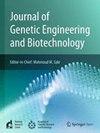利用RNAi技术设计针对登革热病毒所有血清型非结构基因的sirna——一项计算研究
IF 2.8
Q3 Biochemistry, Genetics and Molecular Biology
Journal of Genetic Engineering and Biotechnology
Pub Date : 2025-06-23
DOI:10.1016/j.jgeb.2025.100523
引用次数: 0
摘要
登革热是一种由埃及伊蚊和白纹伊蚊引起的病毒性疾病,可导致严重的健康并发症,包括登革出血热和登革休克综合征。这种疾病在孟加拉国、印度、缅甸和泰国等亚洲国家加剧,自2015年以来经常爆发,部分原因是缺乏针对这种凶猛病毒的有效疫苗或治疗方法。登革病毒(DENV)的非结构(NS)基因被认为在病毒复制中起着至关重要的作用。针对现有DENV血清型的NS基因,我们旨在设计一种具有沉默NS基因能力的潜在小干扰RNA (siRNA),从而为抗病毒治疗提供基础策略。在这项研究中,综合计算方法包括NCBI数据库的数据收集,GC含量分析,DENV所有血清型的保守性预测,mRNA-siRNA双工热力学评估,siRNA功效评估,分子建模和结构优化,分子对接。这些分析预测了三种有效的sirna (S2, S3和S11),它们有能力沉默DENV使用的所有NS蛋白编码基因。基于分子动力学(MD)模拟、主成分分析(PCA)和自由能分析(FEL)等附加分析,推荐了两种sirna (S2和S11)作为潜在的治疗药物,可以通过RNAi途径有效降解病毒NS蛋白编码基因。而S2 (Guide: 5’- uguuuuucgccuuuuuccguu -3’)和Passenger: 5’- CGGAAAAAGGCGAAAAACACG-3’)分子与S11相比被认为是最有前途的siRNA。这项研究为化学合成未来抗病毒药物的发现提供了基础贡献,可用于对抗DENV,特别是在频繁爆发的亚洲地区。尽管如此,在这些sirna作为分子治疗手段之前,还需要进行体内验证和进一步的评估。本文章由计算机程序翻译,如有差异,请以英文原文为准。
Designing siRNAs against non-structural genes of all serotypes of Dengue virus using RNAi technology – A computational investigation
Dengue is a viral disease caused by Aedes aegypti and Aedes albopictus mosquitoes, leads to severe health complications, including dengue hemorrhagic fever (DHF) and dengue shock syndrome (DSS). The disease has intensified in Asian countries such as Bangladesh, India, Myanmar, and Thailand, with regular outbreaks since 2015, partly due to the lack of effective vaccines or treatments against this ferocious virus. Nonstructural (NS) genes of Dengue virus (DENV) are believed to play vital role in viral replication. Targeting the NS genes of existing serotypes of DENV, we aimed to design a potential small interfering RNA (siRNA) that has the capability to silence the NS genes hence, provide a ground strategy for antiviral therapeutics. In this investigation, a comprehensive computational approach encompassing data collection from NCBI database, GC content analysis, conservation prediction across all DENV serotypes, mRNA-siRNA duplex thermodynamic assessment, siRNA efficacy evaluation, molecular modeling and structural refinement, molecular docking were performed. These analyses anticipated three efficient siRNAs (S2, S3 and S11) that could have the capability to silence all the NS protein-coding genes employed by the DENV. Based on additional analysis including molecular dynamic (MD) simulation, principal component analysis (PCA) and free energy landscape (FEL), two siRNAs (S2 and S11) were recommended as potential therapeutics that could effectively degrade viral NS protein-coding genes through the RNAi pathway. However, S2 (Guide: 5′-UGUUUUUCGCCUUUUUCCGUU-3′ and Passenger: 5′- CGGAAAAAGGCGAAAAACACG-3′) molecule is supposed to be appeared the most promising siRNA compared to S11. This study is the foundational contribution enabling chemically synthesized future antiviral drug discovery for combating DENV, especially in the Asian region where frequent outbreaks are common. Nonetheless, in vivo validation and further evaluations are necessary before these siRNAs can be advanced as molecular therapeutics.
求助全文
通过发布文献求助,成功后即可免费获取论文全文。
去求助
来源期刊

Journal of Genetic Engineering and Biotechnology
Biochemistry, Genetics and Molecular Biology-Biotechnology
CiteScore
5.70
自引率
5.70%
发文量
159
审稿时长
16 weeks
期刊介绍:
Journal of genetic engineering and biotechnology is devoted to rapid publication of full-length research papers that leads to significant contribution in advancing knowledge in genetic engineering and biotechnology and provide novel perspectives in this research area. JGEB includes all major themes related to genetic engineering and recombinant DNA. The area of interest of JGEB includes but not restricted to: •Plant genetics •Animal genetics •Bacterial enzymes •Agricultural Biotechnology, •Biochemistry, •Biophysics, •Bioinformatics, •Environmental Biotechnology, •Industrial Biotechnology, •Microbial biotechnology, •Medical Biotechnology, •Bioenergy, Biosafety, •Biosecurity, •Bioethics, •GMOS, •Genomic, •Proteomic JGEB accepts
 求助内容:
求助内容: 应助结果提醒方式:
应助结果提醒方式:


